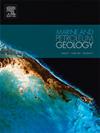Orbital pacing of the early Eocene source rock deposition in Tunisia (Bou Dabbous Formation): Astrobiochronological insights into cyclicities through surface-subsurface integration
IF 3.7
2区 地球科学
Q1 GEOSCIENCES, MULTIDISCIPLINARY
引用次数: 0
Abstract
The Early Eocene Bou Dabbous Formation (BDF) source rock is an economically important source rock in the SW Neo-Tethys covering most of the Ypresian outer ramp to basin deposits in Tunisia. The main rock types of the BDF in central Tunisia include globigerinids-rich grey to black laminated marl and limestone, which occur with an obvious cyclicity at astronomical timescales. This study examines two high-resolution borehole records from northern and eastern Tunisia and an outcrop analog in central Tunisia. The datasets examined were total organic carbon (TOC), magnetic susceptibility, CaCO3, δ13C, δ18O, and Gamma-Ray (GR). We aim to investigate the relationship between the rhythmic patterns observed at the BDF outcrop and the Milankovitch cycles and contextualize the findings within the Ypresian Astrochronological Time Scale (YATS). Additionally, we will discuss the impact of astronomical forcing on sea-level variations and the upwelling system during a greenhouse world. Field measurements and power spectra of the untuned data reveal a hierarchy of cycles throughout the BDF with ∼11.1 m, 4.1, 2.4 m, 1.1 m, and 0.6 m wavelengths. Tuning the 11.1 m cycles to the 405 kyr eccentricity cycle, the astronomical parameters—eccentricity, obliquity, and the precession index—become apparent. The 405 kyr eccentricity cycle is linked to relative sea-level changes inferred from sequence stratigraphy analysis and sedimentary noise modeling. Periods with increased TOC are associated with strong obliquity forcing inferred from the power decomposition analysis and the strong 173-kyr obliquity modulation cycles. The Ypresian record from Tunisia demonstrates the orbital pacing on the strength of the upwelling system, by affecting both the sea level and the climatic belt (wind regime). From 53.89 Ma to 53.2 Ma (TOC >2 wt %), our model demonstrates that obliquity-driven changes in water stratification led to episodes of varying oxygen levels at the bottom of the basin, affecting organic matter decay and preservation. During the Early Eocene Climatic Optimum, changes in climatic belts and wind patterns, along with rising sea levels, led to a shift in the high organic matter accumulation zone. This resulted in a weakened upwelling system in central Tunisia and reduced organic matter accumulation (TOC <0.5 wt%).
突尼斯早始新世烃源岩沉积(Bou Dabbous组)的轨道节奏:通过地表-地下整合对旋回的天体生物年代学见解
早始新世Bou Dabbous组(BDF)烃源岩是新特提斯西南地区重要的经济烃源岩,覆盖了突尼斯伊普雷斯外斜坡至盆地沉积的大部分地区。突尼斯中部BDF的主要岩石类型包括富含灰色到黑色的层状泥灰岩和灰岩,它们在天文时间尺度上具有明显的旋回性。本研究检查了突尼斯北部和东部的两个高分辨率钻孔记录以及突尼斯中部的一个露头模拟记录。检测的数据集包括总有机碳(TOC)、磁化率、CaCO3、δ13C、δ18O和伽马射线(GR)。我们的目的是研究在BDF露头观测到的节律模式与米兰科维奇旋回之间的关系,并将这些发现置于伊朗天文时间尺度(YATS)的背景下。此外,我们将讨论在温室世界中天文强迫对海平面变化和上升流系统的影响。现场测量和未调谐数据的功率谱揭示了整个BDF的周期层次结构,波长为~ 11.1 m, 4.1 m, 2.4 m, 1.1 m和0.6 m。将11.1 m周期调整为405 kyr的离心周期,天文参数-离心率,倾角和岁差指数-变得明显。405 kyr的偏心旋回与层序地层学分析和沉积噪声模拟推断的相对海平面变化有关。TOC增加的周期与从幂分解分析推断的强倾角强迫和强173-kyr的倾角调制周期有关。来自突尼斯的埃及记录通过影响海平面和气候带(风态),证明了上升流系统强度的轨道节奏。从53.89 Ma到53.2 Ma (TOC >2 wt %),我们的模型表明,倾斜驱动的水分层变化导致盆地底部不同的氧水平,影响有机质的腐烂和保存。在始新世早期气候最适期,气候带和风型的变化以及海平面的上升导致了有机质高富集带的转移。这导致突尼斯中部的上升流系统减弱,有机质积累减少(TOC <0.5 wt%)。
本文章由计算机程序翻译,如有差异,请以英文原文为准。
求助全文
约1分钟内获得全文
求助全文
来源期刊

Marine and Petroleum Geology
地学-地球科学综合
CiteScore
8.80
自引率
14.30%
发文量
475
审稿时长
63 days
期刊介绍:
Marine and Petroleum Geology is the pre-eminent international forum for the exchange of multidisciplinary concepts, interpretations and techniques for all concerned with marine and petroleum geology in industry, government and academia. Rapid bimonthly publication allows early communications of papers or short communications to the geoscience community.
Marine and Petroleum Geology is essential reading for geologists, geophysicists and explorationists in industry, government and academia working in the following areas: marine geology; basin analysis and evaluation; organic geochemistry; reserve/resource estimation; seismic stratigraphy; thermal models of basic evolution; sedimentary geology; continental margins; geophysical interpretation; structural geology/tectonics; formation evaluation techniques; well logging.
 求助内容:
求助内容: 应助结果提醒方式:
应助结果提醒方式:


